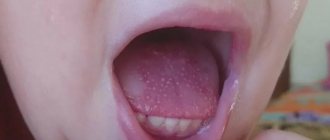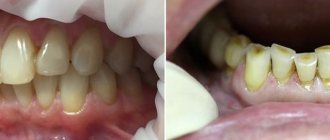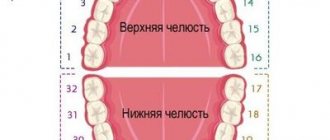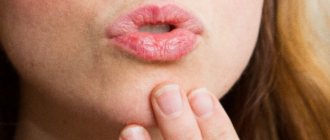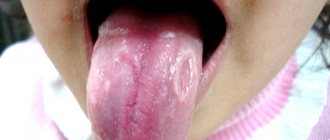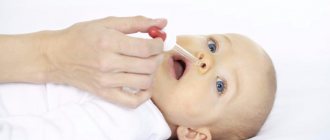Herpangina is one of the most common viral diseases in children. Almost everyone experiences this disease in childhood, although this diagnosis also occurs in adults. From a scientific point of view, the very name “herpetic sore throat” was incorrectly given to the disease. Previously, the disease was little studied. Scientists, noticing the similarity of rashes during the disease with those of herpes, came to the conclusion that the causative agent of the disease was the herpes virus, and gave the disease a name that has stuck and is found in the medical literature in exactly this form. Although the disease has nothing in common with herpes infection. It has been established that the cause of herpetic sore throat is enteroviruses - Coxsackie viruses of groups A and B and ECHO viruses (echoviruses). In medical reference books you can find different versions of the names of this disease: aphthous tonsillitis, vesicular pharyngitis, herpetic tonsillitis, herpangina, etc.
As already mentioned, children under ten years of age are at risk: infants, preschoolers and children of primary school age. The severity of the disease depends on the age of the child. The disease is most severe in children in the first year of life. Preschoolers are more often infected because at this age they do not pay due attention to hygiene, have contact with animals and are often in children's groups. To become infected, it is enough to eat unwashed fruit. This should also include the immaturity of immunity at an early age. The disease is highly contagious, and often its outbreaks become epidemic. It is noteworthy that this disease does not occur in babies in the first months of life - the antibodies found in mother's milk create some kind of immunity to herpangina.
One can trace the obvious seasonality of herpetic sore throat: the peak occurs in summer and autumn. As a rule, having been ill once, a child becomes immune to re-infection, so this disease is less common among adolescents and adults.
Infection can occur in one of three ways:
- airborne
- contact
- fecal-oral.
With the airborne method, infection occurs by sneezing, coughing, or talking with a carrier of the virus. In case of contact - through discharge from the nasopharynx. With the fecal-oral method - through dirty hands, through unwashed food, toys and pacifiers, which is especially typical for children.
Even a recovering person can still spread the infection around him for about a month, so it is believed that herpes sore throat is highly contagious: a child can easily become infected in kindergarten from a baby who does not even have obvious symptoms of the disease. If one family member gets sick, most likely everyone will suffer from the disease.
How does infection spread throughout the body? First, the virus from the nasopharynx reaches the intestinal lymph nodes through the lymph flow. Already in the intestines, the virus gains strength and enters the blood, and severe inflammation begins in the oropharynx.
What causes red dots in the sky?
Experts identify several factors that contribute to the appearance of red dots on the palate in a child or adult:
- Pathological processes in the circulatory system and vessels.
- Infectious diseases.
- Allergic reaction.
- Rare diseases.
Based on the causes and individual characteristics of the body, a red rash can appear either once in a lifetime or quite often. If spots appear repeatedly, then we can talk about herpes viruses, thrush or enteroviral infections.
When exposed to infection, in addition to red dots on the palate, the child’s temperature rises, pain in the throat and larynx appears, weakness, and it becomes painful to swallow. The rash affects not only the palate, but also the tongue, as well as the inside of the cheeks. Infections that cause a rash include:
- Flu.
- Roseola.
- Scarlet fever.
- Meningitis.
- Typhus.
- Rubella.
- Staphylococcal infections.
- Chickenpox.
- Mononucleosis.
- Erythema.
- Syphilis.
Children suffer from chickenpox, rubella and scarlet fever in a milder form than adults, receiving immunity for life. In adults, these diseases occur with complications. But coping with herpes sore throat and stomatitis is much more difficult for children. These diseases progress quickly and greatly worsen the child’s condition.
Course of herpetic sore throat
The diagnosis of herpetic sore throat can be made by an otolaryngologist, therapist or pediatrician after examining the patient and clarifying his complaints. To monitor changes characteristic of a viral infection, the doctor may prescribe a general blood test, and to confirm enteroviral sore throat, a specialist may prescribe a pharyngeal smear and a blood test for specific antibodies. The pathogen can also be detected in stool or inflammatory fluid that is released from vesicles1,4.
Manifestations of herpetic sore throat can go away on their own in less than 10 days. But in any case, at the first symptoms of the disease, you should definitely consult a doctor. You cannot self-medicate2,3.
In some cases, herpetic sore throat can cause complications from the nervous system. In this case, 1 appears:
- severe spasm of the neck muscles, due to which the child cannot bend his head;
- weakness of the muscles of the limbs;
- disturbance of consciousness.
A severe complication of herpetic sore throat is damage to the soft membranes of the brain, brain and spinal cord1,3.
Newborns are at highest risk of developing complications, so they need careful treatment and care3. It is important to maintain hydration and give your child enough fluids1.
Up to contents
Herpetic stomatitis
With stomatitis, spots in the throat range from light pink to red. Areas with the rash may merge or be located far from each other. There are several types of stomatitis, among which herpetic stomatitis is especially common.
This disease is accompanied by headache, high fever, and red dots form on the upper palate, tongue, lips, and cheeks. These points turn into bubbles and explode to form red erosions. The herpes virus remains in the body for life. With strong immunity, it is in an inactive phase, and will manifest itself in the following cases:
- With exacerbation of chronic inflammatory processes.
- After a course of corticosteroids.
- In case of trauma to the mucous membrane.
- During emotional turmoil, allergies, vitamin deficiency.
- When the immune system is weakened.
Treatment of herpetic stomatitis should be prescribed by a qualified dentist.
A dental disease that causes a red rash in the mouth
Stomatitis is a disease that can cause the formation of red dots on the upper palate. This is an inflammatory process that occurs in the oral mucosa. It can be of fungal, viral or bacterial origin - it all depends on what specific pathogen has penetrated the mucous membrane.
Viral stomatitis
Caused by the herpes virus, small rashes appear not only on the palate, but also on the inside of the cheeks and lips, and tongue. The first two days of illness, the rash remains red and large, and then it transforms into blisters that are filled with serous fluid - clear or cloudy.
Viral stomatitis in each case is accompanied by elevated body temperature, weakness, lack of appetite and pain, a burning sensation in the mouth. This form of the disease is mainly diagnosed in adults and newborns.
Bacterial form of pathology
Most often, the oral mucosa is affected by staphylococcus and streptococcus. It is the latter that is considered the most dangerous, because it provokes various kinds of complications, including general blood poisoning. Bacterial stomatitis in almost every case ends with the development of tonsillitis, tracheitis or pharyngitis.
Red dots appear on the white palate, they never merge, but cause some discomfort to the patient: they itch, there is a burning sensation, the sensitivity of the mucous membrane to hot and cold, sour and salty increases. After a few days, the rash becomes barely noticeable, but the patient’s body temperature rises, and one of the above diseases rapidly develops.
Fungal stomatitis
Most often, the fungus affects the mucous membranes of those people who have weakened immune systems. In an adult, this can happen due to prolonged use of certain medications or a long course of the disease. Children often suffer from fungal stomatitis. “Thrush” develops due to constant licking of toys, pieces of furniture and imperfect immunity due to age.
There are not only red rashes in the mouth, but also a white coating. It is characteristic of this disease and helps to make an accurate diagnosis and prescribe effective treatment. Additional symptoms include pain and burning in the mouth, restlessness in a child, and a feeling of fatigue in an adult.
Angina
Herpetic sore throat is also a fairly common cause of the formation of red dots in the throat on the roof of the mouth. The disease is characterized by high fever that lasts for several days, pain when swallowing, discomfort in the abdomen, and enlarged lymph nodes.
Streptococcal sore throat is accompanied by general malaise, headache, and high body temperature. The tonsils become loose and covered with plaque. In this case, antibiotic therapy is used, but the treatment regimen must be drawn up by a qualified specialist.
Causes of herpangina
Herpangina can be caused by about 70 serotypes of enteroviruses. Most often these are Coxsackie B, Coxsackie A17 viruses and enterovirus 711.
Since the only carrier of enteroviruses is humans, you can become infected through contact with a sick person or with a virus carrier who has no symptoms of the disease1. According to the literature, the number of virus carriers can be up to 46% of people2.
The virus is released into the external environment with feces and droplets of saliva. It is also contained in bubbles that appear in the patient’s throat. Enterovirus infections most often affect children, although the disease also occurs in adults5.
The patient or virus carrier excretes viruses from the upper respiratory tract within 3 weeks after infection, and with feces - up to 8 weeks. In the first two weeks, herpetic sore throat is most contagious1.
You can become infected in the following ways:
- through dirty hands, objects and food if they are exposed to the virus;
- drinking contaminated water from a reservoir;
- upon contact with a patient or virus carrier.
The herpangina virus is also transmitted transplacentally - from mother to fetus3.
Up to contents
Other reasons for finding red dots in the sky
Red dots on the upper palate may be the result of the following rare diseases:
Pyogenic granuloma
Occurs in a place often subject to trauma. It is necessary to excise the tumors at the root, after which electrocoagulation therapy is prescribed.
Kaposi's sarcoma
It is a malignant neoplasm with a purple hue. Local chemotherapy is prescribed, and measures are taken to increase the patient’s immunity.
Pathechia in the sky
These are small flat spots that often appear during mononucleosis. May be a manifestation of smallpox, thrombocytopenia, typhoid fever and endocarditis.
If a red rash occurs in the mouth, you do not need to make a diagnosis and prescribe treatment yourself.
It is necessary to consult with a specialist, find out the cause of the spots and receive appropriate treatment. The DentalGuru dental clinic employs experienced and professional dentists who guarantee painless and effective treatment of stomatitis and other dental diseases. This article is for informational purposes only, please consult your doctor for details!
Associated symptoms
If you find red spots in your mouth, you should consult a specialist. As a rule, most of the listed diseases are also accompanied by the following manifestations:
- local pain,
- itching and burning,
- bad breath,
- swelling and inflammation of the gums,
- local temperature rise,
- discomfort when chewing, swallowing, communicating.
If these symptoms appear, you should consult a doctor.
Effective drugs
Treatment of a red throat with white dots in a child is carried out with the help of Acyclovir, Valacyclovir, Alfaron, Cycloferon.
Thanks to rinsing with Hexoral and Orasept, you can get rid of painful sensations and reduce the number of tumors in the throat. It should be noted that such drugs are most often prescribed to children, since these drugs are safe and do not harm the general health of children.
The duration of treatment is determined by a specialist depending on the severity of the disease. Many medications have contraindications, so you should not risk your health.
Scarlet fever - symptoms and treatment
Early complications
In the case of a severe course with a toxic form, a terrible complication develops - toxic shock .
Purulent-septic complications may occur: peritonsillar (next to the palatine tonsil) abscess, neck phlegmon, purulent otitis and mastoiditis (inflammation of the mastoid process of the temporal bone), sinusitis and sepsis. In these cases, immediate resuscitation and surgical actions are needed. But the most disabling complications are associated with autoimmune reactions when acute rheumatic fever . The full picture includes five symptoms: inflammation of the tissues of the heart, migratory polyarthritis, chorea, annular erythema and rheumatic nodules on the skin. It develops more often in children 7-15 years old, this is due to the epidemiology of scarlet fever and streptococcal infections. In adults, chronic forms are more often detected. According to the State Statistical Report in Russia in 2014, the prevalence of rheumatic fever is:
- 1.8 per 100 thousand children from 0 to 14 years - acute forms;
- 11.8 per 100 thousand children and 118.4 per 100 thousand of the total population are chronic forms [12].
Late complications
Late complications include diseases that are not directly related to the pathogen and are caused by impaired immune response: carditis, arthritis, chorea and glomerulonephritis.
Carditis occurs with inflammation of the heart valves, the mitral and aortic valves are most often affected, valvular insufficiency and regurgitation develop (backflow of blood through the valves). On examination, an organic systolic murmur is heard. Treatment with anti-inflammatory drugs does not always lead to improvement, and in some cases chronic heart disease develops. Against the background of blood volume overload, the symptoms of heart failure intensify. Then the patient requires surgical treatment with valve surgery.
Arthritis is an inflammation of mainly large joints, accompanied by pain, swelling, and stiffness in movement. It is characterized by damage to several joints, most often the knees and ankles, and migratory inflammation. Good response to anti-inflammatory therapy. In case of inadequate treatment and genetic predisposition, a chronic course of arthritis develops with repeated attacks and joint deformation.
Chorea sometimes occurs after 6 months. A person develops gait disturbances, involuntary, uncontrolled movements of the arms, legs, body, and facial expressions, which are usually excessively expressed. From the outside, the condition resembles dancing, hence the name. On examination, muscle tone is reduced, reflexes are animated, sweating is pronounced, temperature is unstable, and excessive emotionality is present. Long-term antibiotics, anti-inflammatory and anticonvulsant drugs are effective in treatment.
PANDAS syndrome stands for Pediatric Neuropsychiatric Autoimmune Disorder. The complication was discovered relatively recently, at the end of the 20th century. The characteristic symptoms of this disorder are obsessive-convulsive seizures. The patient develops obsessive thoughts and movements, motor or vocal tics, emotionality and memory impairment may appear. With antibacterial and immune therapy, improvement occurs, but with repeated streptococcal infection or a stressful situation, the symptoms return.
Glomerulonephritis is an autoimmune kidney disease. Characteristic symptoms are edema, dysuria (impaired urination), hematuria (blood in the urine), increased blood pressure, and renal failure. Assessing a general urinalysis helps in diagnosis, especially with mild symptoms. In therapy, water and salt are limited, antibiotics, diuretics, antihypertensive, anti-inflammatory drugs are used, and in case of renal failure - dialysis [12][13].
Note to the patient
If a red rash appears in the throat, it is important to seek help from a specialist, since this phenomenon is not a normal physiological feature of the body. In frequent cases, a red throat and white dots on the tonsils indicate that an infectious disease is developing.
To prevent the development of serious complications, it is necessary to undergo a thorough medical examination by qualified specialists. As medical practice shows, with timely treatment you can get rid of the disease within a week. To prevent the development of the disease, it is important to promptly treat other pathological conditions, take measures to strengthen the immune system, and regularly visit a doctor. To strengthen the immune system, doctors advise:
- eat properly and balanced;
- take vitamin complexes;
- to live an active lifestyle;
- avoid overwork and stress;
- walk more in the fresh air;
- do physical education.
At home, it is not possible to identify the disease that caused the appearance of red spots on the throat. Only after a thorough medical diagnosis is the doctor able to make a diagnosis and prescribe effective therapy. The duration of the course of treatment and dosage are determined strictly by the doctor, depending on the severity of the disease and the physiological characteristics of the patient’s body. Traditional recipes should be used exclusively according to the recommendations of a specialist.
Causes
The cause of the development of the pathology is the herpes simplex virus type 1. It belongs to DNA viruses belonging to the Herpesviridae viral family. The pathogen multiplies rapidly in the epithelial cells of the oral mucosa. Then it enters nearby lymph nodes (submandibular) and continues to reproduce in them. Then it enters the blood and migrates to the parenchymal organs (spleen, liver, kidneys). There it multiplies and enters the bloodstream again. As a result, it again appears in large quantities in the epithelial cells of the skin and mucous membranes. They are massively defeated. It is localized in the oropharynx, oral cavity, nose, lips, and nearby skin. Stomatitis and herpes of the skin and mucous membranes develop when the infection generalizes simultaneously.
Children become infected with it as follows:
- through contact and everyday life (using shared utensils, toys, through kissing);
- airborne (coughing, sneezing);
- from a sick mother to the fetus through the placenta or during childbirth.
A baby can become infected from sick adults, children, and carriers.
The following factors contribute to the development of the disease:
- previously suffered inflammatory processes;
- previous antibiotic therapy;
- deficiency of microelements and vitamins in the body;
- mechanical damage to the skin and mucous membranes;
- insufficient fluid intake;
- poor oral hygiene.
In children, the virus is especially easily transmitted through contact. The infectious process quickly spreads to healthy areas.
Pediatric infectious diseases
Many infectious diseases that manifest as a rash on the palate are known as “childhood” diseases. But this does not mean that adults are not susceptible to infection. Having suffered from such diseases once, a person receives lifelong immunity. But if you do not get the same chickenpox in childhood, there is a risk of contracting this infection in adulthood.
Rubella
With rubella, red spots may first appear on the child's palate, and only then on the face and body. Rubella usually resolves easily and without complications in childhood, with the exception of infants up to one year old. These babies endure the disease very hard, so scarlet specks in the mouth, which quickly merge into specks, should alert parents: this may be the first symptom of rubella. This disease is also dangerous for adults who did not have it in childhood, especially for pregnant women.
Measles
As with rubella, with measles a rash in the mouth may appear earlier than on the body - sometimes within a day or two. But the nature of the rash is very different: with measles, the rash looks like dots of white or pale gray color, reminiscent of semolina. Their accumulations on the upper palate, tonsils and back of the throat are surrounded by a pinkish border, this phenomenon is called Belsky-Filatov syndrome.
Chicken pox
With chickenpox, a red rash in the mouth should alert you, as it indicates a complicated course of the disease. Bubbles filled with liquid can shed the gums, tongue, inner surfaces of the baby’s lips and cheeks, and are often found at the top - on the hard and soft palate. Breaking through, they form ulcerations in the oral cavity.
Scarlet fever
With scarlet fever, a small red rash covering the child's body may also appear on the upper palate. The mucous membranes of the pharynx with scarlet fever are bright red, the regional lymph nodes and tonsils are enlarged, the tongue becomes crimson in color and is covered with a white coating - see photo.
Speckled rashes are usually accompanied by a very high fever and vomiting, and in severe forms of the disease - convulsions and clouding of consciousness.
- Causes of rashes in children
Roseola
Since the disease begins with a high fever, and after a couple of days, when the temperature subsides, a rash appears, roseola is often mistaken for ARVI and an associated allergy to medications. Small red spots and blisters in the throat and palate precede the appearance of similar rashes on the body. Their presence is accompanied by redness of the pharynx and pain when swallowing.
The difference between a rash in the mouth and on the body with roseola and any other is that it disappears when pressed.
Traumatic stomatitis in children
A specific form of traumatic stomatitis in children is Bednar's aphthae . This is a traumatic erosion of the oral mucosa. In children, unlike adults, the mucosal epithelium consists not of four layers, but of two, so it is easily injured. The cause may be early teething, a rough nipple from the mother, or a long nipple on the bottle. Erosion is most often located in the middle of the palate or opposite the cutting edge of the teeth. The child begins to refuse food, cries, and sleeps poorly.
Traumatic stomatitis also occurs in children when wearing braces. Erosions have uneven edges, are painful, and are usually located on the mucous membrane of the cheeks and lips, less often on the tongue.
Treatment of herpetic sore throat
Patients with complications require hospitalization in an infectious diseases hospital and treatment under the supervision of specialized specialists - a neurologist and a cardiologist. If the doctor has recommended treatment at home, it is necessary to closely monitor the patient's condition2.
The sick person should be isolated and stay in a clean, well-ventilated area so as not to infect other family members. Quarantine must be observed until symptoms subside1.
For herpangina you should 1,3,4:
- Wash your hands as often as possible, including after feeding and changing a sick child’s diaper.
- Disinfect surfaces and objects with which the patient has been in contact.
- Drink enough fluids to avoid dehydration. At the same time, pay attention to the temperature of the drink: hot, warm drinks irritate the mucous membranes and cause additional discomfort. You can drink cool drinks.
- Consume food in liquid or mushy form. Spicy, salty, sour foods, including fresh fruits even in the form of puree, are not suitable for a patient with herpetic sore throat.
- Rinse your mouth with a saline solution after every meal to maintain oral hygiene and prevent bacterial infections from erosions.
- Use a soft toothbrush to reduce trauma to the mucous membrane.
Currently, there is no proven antiviral drug to treat herpangina by acting on its causative agent. Sometimes a doctor may prescribe medications that support local immunity of the pharyngeal mucosa1. Antibiotics are not prescribed for herpangina6.
The goal of treatment for herpangina is to relieve the symptoms of the disease4.
If the body temperature is above 38.5°C, physical methods such as cold compresses and ice packs may be used. Your doctor may also recommend anti-inflammatory and antipyretic medications1. Local treatment includes agents with anti-inflammatory, analgesic, enveloping and antiseptic effects1.
For the symptomatic treatment of herpetic sore throat, the doctor may prescribe the drugs HEXORAL®7,8,9,10,11. It is convenient to use HEXORAL® spray to irrigate the pharyngeal mucosa. The active substance of the spray is hexethidine. It acts against the main bacteria found in the oral cavity and pharyngeal mucosa8. The drug is also active against some viruses and fungi of the genus Candida8. Thanks to the local anesthetic effect of hexethidine, HEXORAL ® spray helps reduce pain8. HEXORAL®7 solution is suitable for rinsing. The use of HEXORAL ® spray and solution is allowed in children over 3 years of age7,8.
If herpangina causes severe pain and discomfort, adolescents over 12 years of age and adults can benefit from HEXORAL ® TABS EXTRA lozenges, which contain the anesthetic lidocaine10. For children over 4 years of age, HEXORAL ® TABS lozenges may be suitable. The anesthetic benzocaine in their composition helps reduce pain in the throat and mouth9.
All medications for herpetic sore throat should be used only after consultation with a doctor. In case of severe erosions, HEXORAL ® solution and spray are contraindicated7,8, and lozenges can only be prescribed by a specialist after examining the pharynx9,10.
Up to contents
The information in this article is for reference only and does not replace professional advice from a doctor. To make a diagnosis and prescribe treatment, consult a qualified specialist.
Possible complications
In the absence of appropriate treatment for a red rash that has formed on the palate, changes in the cellular structure and epithelial tissue are likely.
This can cause the red rash to increase in size and trigger the development of the following diseases :
- Pyogenic granuloma. It is characterized by thickening of blood vessels with disruption of their blood flow. The dots in the sky will change their usual reddish hue to blue. They will interfere with conversation and eating. In the future, they can cause malignancy and can cause death.
- Petechiae of the palate. The last stage of hardening of reddish spots on the sky, when the baby was not helped. It is characteristic of pathology that new ones can form near previous formations. In many situations, such adverse effects are provoked by a rash associated with herpes virus or mononucleosis.
- Kaposi's sarcoma. A red rash of viral origin that is not eliminated in a timely manner can transform into flat growths of bright red color. This pathology, characteristic of children with weak immunity or infected with HIV, is a complex disease with an extremely high mortality rate.
Pyogenic granuloma
Petechiae of the palate
Kaposi's sarcoma
It is possible to eliminate such complications with timely treatment of emerging diseases.
Video about clinical observation of Kaposi's sarcoma:
The main causes of rashes
The inside of the pharynx is protected by ciliated epithelium. The tissue is equipped with cilia that constantly move and push food into the esophagus. Quite often, rashes in the throat occur due to damage to the ciliated epithelium by bacterial or fungal infections. As medical practice shows, most often bacteria are the main cause of the appearance of red dots on the throat. Some parents, upon discovering red spots in the throat of their baby, begin to panic. But you should know that such a manifestation does not always indicate that a serious illness is developing that threatens life. There are several reasons that can trigger the appearance of red dots, namely:
- allergic reaction to food;
- acute respiratory disease;
- disturbances in the functioning of the body's protective function.
If the spots cover the soft palate and the back wall of the pharynx, this indicates that an infectious disease is developing. Quite often, this symptom appears in children due to mechanical damage to the tissue. Over time, the ciliated epithelium is restored, and the scars resolve.
Causes of stomatitis
In children, as in adults, stomatitis can be caused by viruses, fungi, bacteria, allergies and injuries. About six months after birth, the child loses the immunity received from the mother, the protective power of the immune system changes, and the child’s body becomes more susceptible to infections. The oral mucosa in children is more delicate and easier to injure; children also more often “bite” their cheeks after dental treatment due to a temporary loss of sensitivity after anesthesia, which causes traumatic stomatitis.
Children are not always motivated to brush their teeth, so poor hygiene can also cause stomatitis.
With the following diseases, stomatitis is observed in children much more often: chronic tonsillitis, diabetes mellitus, heart defects, chronic hepatitis.
Treatment methods
If you notice a reddish rash in the oral cavity that looks like numerous pimples, you need to find out the doctor’s recommendations. Self-medication of such growths in the mouth is prohibited, since in everyday conditions it is difficult to identify the provoking factor of irritation of the mucous membrane.
General therapy
After diagnosis, which is aimed at detecting pathogenic microorganisms, the specialist prescribes medications that can eliminate the pathological process in the palate.
In many situations the following drugs are used :
- Antibiotics . The doctor prescribes antibiotics in tablets or as injections.
- Antiviral drugs . Such medications are used in situations where a red rash on the palate was caused by a herpes virus. The child is prescribed Zovirax, Valtrex, Acyclovir or Famvir. The choice of drug is made by the doctor, based on the condition of the oral cavity.
- Antihistamines . The specialist prescribes medications such as Suprastin, Aleron, Ketotifen. They are taken in tablet form or administered intramuscularly.
Zovirax
Valtrex
Acyclovir
Famvir
Suprastin
Aleron
Ketotifen
Treatment of the rash on the palate is extremely important, since in its absence, swelling of the mucous membrane is likely to occur with further spread to the larynx.
Local therapy
Taking into account the diagnosis, the doctor prescribes therapy. For viral infections of the oral cavity, antibiotics are prescribed; for the treatment of herpes, antiviral drugs are prescribed. When a fungus is detected, antibacterial medications are used.
In addition, the specialist can prescribe local therapy, which helps eliminate red spots on the palate.
Such means include:
Miramistin
Kamistad
Holisal
Metrogil Denta
Solcoseryl
Any remedy should be used after consultation with a doctor.
Traditional methods
It is possible to eliminate unpleasant symptoms through traditional therapy.
It should be borne in mind that treatment without appropriate diagnosis can worsen the situation, therefore it can only be of an auxiliary nature. Rinsing helps remove stains :
- 0.5 tsp. soda and salt, a few drops of iodine per 1 tbsp. water;
- 2 tbsp. l. chamomile is poured into 0.2 liters of boiled water and infused for half an hour, then filtered and diluted to the initial amount;
- propolis infusion, which is diluted with water in a ratio of 1 to 20.
Important! Therapy must be previously agreed with a specialist.
